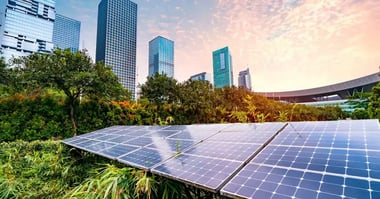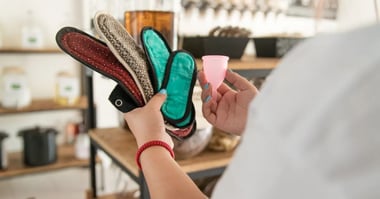Our planet is in a state of flux. This summer, some European regions have seen temperatures reach a record-breaking 115.5 °F (46.4 °C). Just weeks later, the Alps received heavy snowfall in August. And over in the US, New York City saw flooding like never before, after getting a month's worth of rain in just one day.
Climate change has become a reality. But one way we can overcome this threat is by adopting environmental sustainability into our everyday lives — from throwing waste items in the correct bin to introducing a circular supply chain.
This article will discuss everything you need to know about environmental sustainability, outlining how it works, why it’s important, and discussing the Three Pillars of Sustainability.
What's on this page?
01 | What is environmental sustainability?02 | How does environmental sustainability work?
03 | Why is environmental sustainability important?
04 | How to integrate environmental sustainability into today's world
05 | Examples of environmental sustainability
06 | Can businesses benefit from environmental sustainability?
07 | Are there any environmental sustainability regulations?
08 | FAQs
What is environmental sustainability?
Environmental sustainability encourages people to live in a way that doesn’t put stress on natural resources. This way, we can maintain an ecological balance in our planet’s natural environment, which will benefit today’s ecosystems and protect future generations.
This overlaps heavily with the United Nations Brundtland Commission's definition of sustainability: “Meeting the needs of the present, without compromising the ability of future generations to meet their own needs.”
Definitions vary, but one thing remains true — humans are collectively moving away from environmental sustainability, as we continue to consume more materials than the planet can supply.
How does environmental sustainability work?
Sustainability can be broken down into three main focus areas: social, economic, and environmental — otherwise known as the Three Pillars of Sustainability.
Like many three-pronged approaches, these pillars often overlap with each other. So to understand the environmental branch of sustainability, we also need to learn about the other areas.
.jpg?width=1200&height=630&name=Three%20pillars%20of%20sustainability%20(1).jpg)
The Three Pillars of Sustainability
Social
The social pillar of sustainability is focused on ensuring all members of society have fair access to resources and opportunities. In theory, everyone in a healthy society needs to participate for this to work.
Key topics in social sustainability include environmental justice, human health, participation, education, resource security, and sustainable communities.
Economic
This pillar of sustainability involves supporting the economic growth and financial stability of communities and individuals, without compromising their social, environmental, and cultural values.
Key topics in economic sustainability include jobs, incentives, supply and demand, natural resource accounting, and costs.
Environmental
As the name suggests, this pillar of sustainability involves keeping the natural environment healthy, protected, and restored (if necessary).
Key factors in environmental sustainability include ecosystem services, green engineering and chemistry, air quality, water quality, stressors, and resource integrity.
Although it seems like a difficult goal, cities around the world are already working towards environmental sustainability. Find out more by visiting our page on the nine greenest cities in the world.
Why is environmental sustainability important?
Everything on our planet is connected — the smallest ecological disturbance can cause a domino effect of disruption. And our rapid consumption of resources is causing catastrophic changes across the globe — especially as events like Black Friday continue to gain popularity.
In fact, it’s estimated that roughly 10 million hectares of forest are cut down each year — that’s about 12.8 times the size of New York City. On top of this, we consume roughly 4.39 billion metric tons of oil per year, despite knowing that this depleting resource is damaging the planet.
This is not sustainable.
Ultimately, we’re shooting ourselves in the foot by ignoring environmental sustainability. And this isn’t just an issue for future generations anymore — it’s already putting our lives in danger. The World Health Organisation predicts that climate change could cause roughly 250,000 additional deaths per year between 2030 and 2050.
By adopting sustainable practices, and restoring the environment back to its healthy self, we can avoid these unnecessary deaths.
If you want to learn more, head to our page: Environmental Sustainability: Importance, Issues, and Benefits.
How to integrate environmental sustainability into today's world
It’s clear to see that the world is heading down a dangerous path. Thankfully, there are various ways we can work our way back to a healthy planet.
Check out some of the key ways we can collectively work towards environmental sustainability below.
Restore and protect the environment
Ecosystems of all shapes and sizes have taken a huge hit over the past few decades. We have lost one-third of our forests globally by expanding agricultural land. We’ve also wiped out over half of all coral reefs around the world since 1950, and have decimated between a fifth and a third of the world's mangrove forests.
To integrate environmental sustainability into our future, we need to restore these precious habitats. Not only will this increase biodiversity and restore natural resources, but it will also create more natural carbon storage.
Make simple swaps
The global population has now passed the 8 billion mark — and that figure is expected to increase by another 2 billion in the next 30 years. Having more people on the planet means companies are pumping out more products than ever before, with many wrapped in plastic.
Plastic is a notoriously cheap material to produce, which is why many companies have adopted it over the years. But this flimsy material is often discarded after just one use, and takes hundreds of years to degrade, meaning there’s an ever-growing build-up of waste accumulating.
Each of us has a responsibility to make swaps in our lives to avoid adding to this pile of waste. This can be as simple as replacing plastic water bottles with a reusable one, or it could be as big as reinventing the waste management system.
Invest in new technology
We can’t achieve a truly sustainable planet with the increasing population size without developing renewable technologies, and adopting them on a large scale.
This way, communities can continue to live their current lives without polluting the environment and causing further damage to the climate.
By investing more in these developments, we can power towns and cities with renewable energy, create a more sustainable material to package products, and clean up the oceans from the ongoing plastic crisis.
Change our perspective
We all have to change our lifestyles and learn how to live more sustainably.
Not sure where to start? It’s worth looking into sustainable diets, ways to avoid fast fashion, and simple swaps to reduce your plastic waste.
Business owners can also do their bit by adopting more eco-friendly practices, and communicating any progress with employees and shareholders.
Examples of environmental sustainability
If we want environmental change, we need to start modifying living conditions, promoting sustainable business practices, and developing renewable technologies.
Thankfully, we can already see examples of this happening. We’ve listed some of the most common instances below.
Efficient waste management
At least 3.5 million tons of solid waste is generated globally each day — most of which is mismanaged and ends up in the oceans.
To fully eliminate plastic waste over time, the general public needs to be aware of how to dispose of different materials. We’re already seeing this change happening in a lot of European countries, and some areas of the US. However, there are some communities around the world that don’t have access to a proper waste management system.
That’s where CleanHub comes in. We work together with partners to collect plastic waste in areas that currently don’t have infrastructure in place. Want to learn more? Check out our plastic recovery page.
Sustainable agriculture
Historically, we’ve found that farming the same crops repeatedly on the same area of the land reduces soil quality. On top of this, many farmers use pesticides, herbicides, and fertilizers to help grow their crops, which can all leach into the land or pollute the waterways.
However, some farmers have recently adopted sustainable agriculture, in a bid to reduce their impact on the planet. This involves working with the local environment, rather than against it.
Common examples of sustainable agriculture include crop rotation, feeding livestock in a way that doesn’t release high greenhouse gas emissions, planting cover crops, permaculture, and improving water management.
Sustainable forestry
Roughly 10 million hectares of forest are cut down each year — a practice that can’t continue without having catastrophic ramifications.
That’s why sustainable forestry is becoming more popular around the world. It focuses on maintaining, regenerating, and managing the bio properties of the forests.
This can include planting seedlings in depleting forest areas, and thinning existing trees every five years to improve their strength and growth capability.
Sustainable construction
About 25% of global carbon dioxide (CO2) emissions come from the construction industry, according to the Intergovernmental Panel on Climate Change (IPCC).
To cut back on these emissions, industry experts have introduced more sustainable practices — using resources that have minimal impact on the planet, and power building appliances and machinery with renewable energy.
Renewable energy sources
Fossil fuels are one of the biggest contributors to our warming planet. Burning these materials generates toxic emissions that drive climate change, damage ecosystems, and harm human health.
But this isn’t our only option — more countries are now adding clean, green sources to their energy mix. Some of the most common sources of renewable energy include solar, wind, hydro, tidal, and geothermal energy.
Can businesses benefit from environmental sustainability?
Yes, businesses can definitely benefit from environmental sustainability — now more than ever. Adopting green practices in the workplace can:
- Reduce energy costs – Renewable energy is much cheaper than fossil fuels because suppliers don’t have to buy fuel to burn
- Reduce packaging costs – By reducing packaging in the production line, companies won’t have to spend as much on materials
- Attract more customers – The number of conscious consumers is on the rise, and having green credentials is now something customers keep an eye out for
- Improve employee satisfaction – Sustainable businesses tend to provide healthier work environments, which could be why 67% of people are more willing to apply for a job at a sustainable company
Want to learn more? Head to our page on the Top Sustainability Tips for Businesses.
Are there any environmental sustainability regulations?
There are plenty of environmental sustainability regulations around the world, but they tend to vary depending on the country or region you’re in.
For example, the Environmental Protection Agency (EPA) creates environmental laws and regulations in America. It covers any and all topics around environmental health, from air quality to contaminated lands and toxic sites.
Some of its most-known laws include the Clean Air Act, the Clean Water Act, and the Safe Drinking Water Act.
However, in the European Union (EU), the EU environmental policy governs green laws. According to the European Parliament, this policy “rests on the principles of precaution, prevention and rectifying pollution at source, and on the 'polluter pays' principle”.
Violations of environmental law are considered white-collar crimes, with punishments of fines, probation, or jail. Businesses generally face fines for violating environmental crimes, but the amount the company will have to pay will vary from country to country.
Summary
If we want to slow down the acceleration of climate change, we need to move forward with environmental sustainability in mind. If done correctly, this approach can also go hand in hand with businesses, attracting more customers along the way.
FAQs
What is meant by environmental sustainability?
Environmental sustainability focuses on having a society where people can live in a way that doesn’t put stress on natural resources. This way, we can maintain an ecological balance in the world’s natural environment, protecting future generations from material scarcity.
What is an example of environmental sustainability?
There are plenty of examples of environmental sustainability — we just need to make them more central in today’s society. Some of the most common examples include:
- Implementing sustainable agricultural practices
- Integrating efficient waste management systems in all countries
- Carrying out sustainable forestry
How can we maintain a sustainable environment?
We each have a responsibility to make our lives more sustainable, whether that’s on an individual level or a large-scale one.
People can introduce simple swaps in their daily lives to become more sustainable, such as buying products without plastic packaging, reducing water consumption at home, and switching to a greener diet.
Companies can improve their sustainability credentials by cutting back on plastic packaging on the production line, powering offices or warehouses with renewable energy, and introducing green initiatives around the business.

.webp)
-3.png)
.webp?width=380&name=Plastic-on-the-beach%20(1).webp)

.webp?width=380&name=Sustainable%20christmas%20(1).webp)

.webp?width=380&name=ESG-presentation%20(1).webp)
.webp?width=380&name=Buying-online%20(1).webp)


.webp?width=380&name=Sales%20(1).webp)
.webp?width=380&name=Ecommerce-business-owner%20(1).webp)
